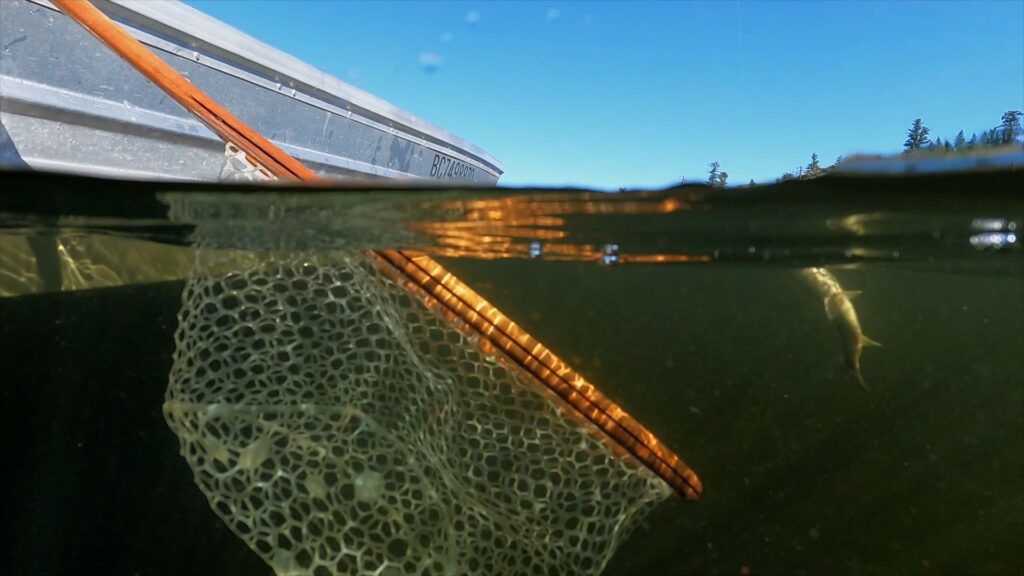Where, When, and How to Catch Fish
Part of the excitement of fishing is planning where and when to go, and what to fish for. This article will help beginner anglers understand where in lakes and rivers to angle for the various fish species found in B.C., the best times to fish, and some suggestions of what to use to catch them.
Quick Tip: Determining a fish’s food source is the key to angling success! For example, are the fish eating insects, other fish, or plants? Are they feeding near the surface, or close to the bottom? Once you know, you can choose the tackle that best imitates their favourite food, and decide where in the water column you should put your lure or bait. Check out this useful chart to see what trout are eating in each month of the year.
Finding Fish in Lakes
The most productive, or nutrient-rich, part of a lake is the shoal area. These shallows, home to sunlight-dependent aquatic plants and insects, make them a “grocery store” for fish. Fish will often be found cruising along the drop-offs at the edge of a shoal. Look for fish surfacing or jumping as clues to whether this is a good place to start fishing.
Rainbow Trout and Brook Char
As a rule, the best seasons to fish for trout are the spring and fall, when water temperatures are moderate. Although trout and char can be caught at any time during the day, morning and evening are best: fish feed most actively then. These fish can be caught still-fishing with bait or by casting and retrieving a small lure or fly. If you’re fishing from a shore or dock, check out these tips to increase your success rate. If you’re fishing from a boat, trolling a lure or a fly is a good method, because you can cover a large area in search of fish. When setting up your tackle, remember that trout and char are generally found in the mid- or top-water area.
Quick Tip: The Freshwater Fisheries Society of BC stocks over 800 lakes and rivers each year. Many lakes are stocked with ‘catchables’ – trout that are large enough to be caught as soon as they are stocked. Get up-to-date stocking information here.
Kokanee
These fish prefer deeper water with cooler temperatures, usually less than 10°C. Kokanee are generally found in the open areas of a lake, at depths of five to 10 metres (15 to 30 feet), where they search for their primary food source: a very small organism called plankton. The best way to fish kokanee is from a boat, slowly trolling. These fish are renowned for having a small soft mouth, so be careful when setting the hook and playing the fish, or you may pull or tear the hook right out. Remember that kokanee like to “school,” or travel in a group; if you catch one, try trolling through the same area again.
Sunfish (Bass, Crappie, Pumpkinseed)
These warm-water species are usually found in shallow water containing weed beds, logs, stumps, or rock piles. Sunfish hang around these structures because they are also home to insects and small fish, their main food sources. Both jigs and worms, fished with a float, are good choices to catch sunfish. Remember, these fish are aggressive feeders; if you don’t get a bite in five to 10 minutes, try another spot.
Finding Fish in Rivers
Rainbow Trout, Cutthroat Trout, Salmon, and Whitefish
In flowing water, these fish prefer pools or runs created below boulders or jams of woody debris which deflect or slow the current, creating back-eddies and backwaters. Fish (trout in particular) like to hold in these productive spots, since they need only use minimal energy while waiting for their next meal to be swept downstream. Mornings and evenings are the best times to fish for these species. Casting lures, or using a float and bait (like worms or fish eggs), are good techniques in these waters. Keep in mind that even though rivers are generally not as deep as lakes, you’ll probably need a little extra weight on your line to offset the pull of the current and get your baits or lures down to within 30 centimetres (one foot) of the bottom, where the fish like to hold.
Suckers, Northern Pikeminnow, and Chub
These species can be targeted year ’round in the warmer regions of B.C. In rivers, they tend to favour slower water, and are commonly found in backwaters or sloughs. Since these fish are usually located on or close to the bottom, still-fishing with a worm can be very productive. All of the fish in this group are relatively easy to catch, and can be caught throughout the day.
Quick Tip: In streams, fish often lie just off the edge of the main current or behind bottom structure (like boulders), where it’s easier for them to swim. While almost hidden, and feeling protected by the cover of the overhead current, they can easily dart out to snatch a meal as it drifts by.
For more tips on when and where to find fish in rivers and lakes, visit our YouTube channel.
